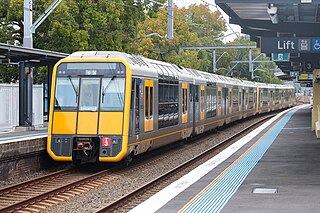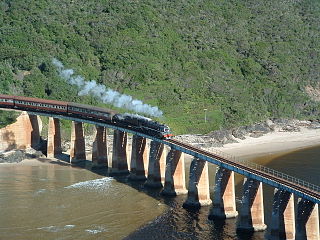Related Research Articles
Different methods of transportation in South Africa include roads, railways, airports, and water. Most people in South Africa use informal minibus taxis as their primary mode of transport. BRT, a bus service, has been implemented in some South African cities to provide more formalised and safer public transport services. These systems have been criticised due to their significant capital and operating costs. South Africa has many major ports, including Cape Town, Durban, and Port Elizabeth.

The Eastern Suburbs & Illawarra Line is a commuter railway line on the Sydney Trains network in the eastern and southern suburbs of Sydney. The line was constructed in the 1880s to Wollongong to take advantage of agricultural and mining potentials in the Illawarra area. In March 1926, it became the first railway in New South Wales to run electric train services.

Adelaide Metro is the public transport system of the Adelaide area, around the capital city of South Australia. It is an intermodal system offering an integrated network of bus, tram, and train services throughout the metropolitan area. The network has an annual patronage of 79.9 million, of which 51 million journeys are by bus, 15.6 million by train, and 9.4 million by tram. The system has evolved heavily over the past fifteen years, and patronage increased dramatically during the 2014–15 period, a 5.5 percent increase on the 2013 figures due to electrification of frequented lines.

The National Railways of Zimbabwe (NRZ), formerly Rhodesia Railways (RR), is a Bulawayo headquartered state-owned enterprise that operates the country's national railway system. It was established in 1893 and is governed by an Act of Parliament. It has a commercial-administrative center in Harare and a supply center in Gweru. The Zimbabwean railway system was largely constructed during the 20th century.

The Outeniqua Choo Tjoe was the last remaining continually-operated passenger steam train in Africa, ending operation in August, 2006. The line on which it operated links the towns of George and Knysna in the Western Cape, South Africa, and was completed in 1928. The scenic 67-kilometre (42 mi) route from George took 3 hours, following the rugged coastline of the Garden Route,and passing through Victoria Bay, Wilderness, Goukamma, and Sedgefield before crossing a bridge over the Knysna Lagoon and ending at the Knysna station.

Transnet SOC Ltd is a large South African rail, port and pipeline company, headquartered in the Carlton Centre in Johannesburg. It was formed as a limited company on 1 April 1990. A majority of the company's stock is owned by the Department of Public Enterprises, or DPE, of the South African government. The company was formed by restructuring into business units the operations of South African Railways and Harbours and other existing operations and products.

The Blue Train is a luxury train that travels an approximately 1,600-kilometre (990 mi) journey in South Africa, between Pretoria and Cape Town. It is one of the most luxurious train journeys in the world. It offers butler service, two lounge cars, an observation car, and carriages with gold-tinted picture windows, in soundproofed, fully carpeted compartments, each with its own en-suite bathroom. The service is promoted as a "magnificent moving five-star hotel" by its operators, who note that kings and presidents have travelled on it.

Rail transport in South Africa is an important element of the country's transport infrastructure. All major cities are connected by rail, and South Africa's railway system is the most highly developed in Africa. The South African rail industry is publicly owned.

Metrorail is an operator of commuter rail services in the major urban areas of South Africa. It is a division of the Passenger Rail Agency of South Africa (PRASA), a state-owned enterprise which is responsible for most passenger rail services in South Africa. The Metrorail system consists of 471 stations, 2,228 kilometres (1,384 mi) of track, and carries an average of 1.7 million passengers per weekday.

Shosholoza Meyl is a division of the Passenger Rail Agency of South Africa (PRASA) that operates long-distance (intercity) passenger rail services. It operates various train routes across South Africa, carrying approximately 4 million passengers annually. Before 2009, Shosholoza Meyl was a division of Spoornet, but it was transferred after the formation of PRASA.

Transnet Freight Rail is a South African rail transport company, formerly known as Spoornet. It was part of the South African Railways and Harbours Administration, a state-controlled organisation that employed hundreds of thousands of people for decades from the first half of the 20th century and was widely referred to by the initials SAR&H. Customer complaints about serious problems with Transnet Freight Rail's service were reported in 2010. Its head office is in Inyanda House in Parktown, Johannesburg.

Nigerian Railway Corporation is the state-owned enterprise with exclusive rights to operate railways in Nigeria.

The Uganda Railways Corporation (URC) is the parastatal railway of Uganda. It was formed after the breakup of the East African Railways Corporation (EARC) in 1977 when it took over the Ugandan part of the East African railways.

Rail transport in Angola consists of three separate Cape gauge lines that do not connect: the northern Luanda Railway, the central Benguela Railway, and the southern Moçâmedes Railway. The lines each connect the Atlantic coast to the interior of the country. A fourth system once linked Gunza and Gabala but is no longer operational.

Portos e Caminhos de Ferro de Moçambique is a state-owned company that oversees the railway system of Mozambique and its connected ports.

VicTrack, trading as the Victorian Rail Track Corporation, is a Victorian Government state-owned enterprise which owns all railway and tram lines, associated rail lands and other rail-related infrastructure in the state of Victoria, Australia, with the exception of the Emerald Tourist Railway Board's heritage Puffing Billy Railway.

The Passenger Rail Agency of South Africa (PRASA) is a South African state-owned enterprise responsible for most passenger rail services in the country.

The South African Railways Class 34-600 of 1974 is a diesel-electric locomotive.

The history of rail transport in Lesotho began in 1905, when the landlocked nation of Lesotho was connected with the railway network of South Africa. The two nations have remained connected by a single railway line ever since.

Urban rail transit in Africa has emerged as a growing form of transit due to rapid urbanization that has occurred in recent decades across the continent. Some of these transit systems are older and more developed, such as the metro in Cairo which opened in 1987. Others such as the light-rail system in Addis Ababa are much more recent, which opened in 2015. A variety of technologies are being used ranging from light-rail, bus rapid-transit, and commuter-rail etc. Africa for several decades saw minimal investment in rail infrastructure, but in recent years due to urban population growth and improved financing options, investment in rail networks has increased.
References
- ↑ "allAfrica.com: South Africa: Kei Rail Project's Safety Permit Renewed". 17 October 2010. Retrieved 17 October 2010.
- ↑ "Kei Rail (South Africa)". Jane's Information Group . Retrieved 17 October 2010.
- ↑ "Kei Rail project steams ahead - SouthAfrica.info" . Retrieved 17 October 2010.
- ↑ "KEI RAIL". Railways Africa. Retrieved 17 October 2010.
- ↑ "KEI RAIL – GROUNDED". Railways Africa. Retrieved 1 December 2010.
- ↑ "KEI RAIL BACK IN OPERATION". Railways Africa. Retrieved 17 August 2011.
- ↑ "News in Brief". Railway Gazette International . 13 September 2011. Retrieved 14 September 2011.